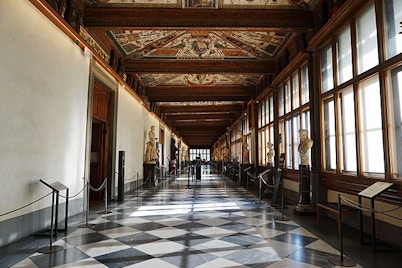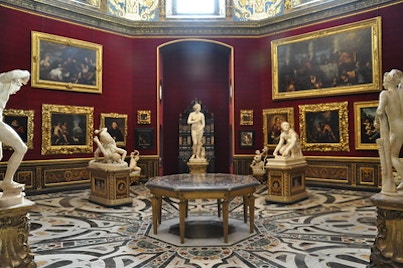Everything about Uffizi Gallery - Collection, architecture, history & highlights
The Uffizi Art Gallery in Florence, one of Europe's oldest museums, houses a remarkable collection of Renaissance masterpieces by renowned artists like Michelangelo and Leonardo da Vinci. Explore ticket options conveniently on our platform.
Founded On
1769
Founded By
Giorgio Vasari

Quick information
RECOMMENDED DURATION
3 hours
Timings
8:15 AM - 6:30 PM
VISITORS PER YEAR
2008625
TICKETS
From € 19.90
NUMBER OF ENTRANCES
5
EXPECTED WAIT TIME - STANDARD
2+ hours (Peak), 30-60 mins (Off Peak)
EXPECTED WAIT TIME - SKIP THE LINE
0-30 mins (Peak), 0-30 mins (Off Peak)
UNESCO YEAR
1982
Fun facts
Wander the Vasari Corridor, a covert passageway linking Uffizi to Pitti Palace across the Arno River, shrouded in historical intrigue.
Journey back to 3100 BCE with the ancient Egyptian masterpiece, the Narmer Palette, residing within Uffizi's renowned collection.
Explore the hidden treasures of Room 35, known as the "Room of the Loeser Bequest," showcasing antique furniture and paintings collected by Charles Loeser.
Book Uffizi Gallery Tickets
Uffizi Gallery Collection

Paintings
The Uffizi Gallery houses around 1,800 Italian Renaissance paintings, showcasing masterpieces by renowned artists such as Botticelli, Leonardo da Vinci, Raphael, and Caravaggio.

Sculptures
The Uffizi's sculpture collection, though smaller than its paintings, includes notable pieces like Michelangelo's 'Tondo Doni,' showcasing Renaissance mastery.

Ancient artifacts
The Uffizi collection goes beyond paintings and sculptures, featuring around 600 ancient artifacts like vases and coins, providing insights into the daily life and art of ancient civilizations.

Prints & Drawings
With a vast array of around 100,000 prints and drawings, the Uffizi Gallery tells the tale of artists' creative processes and the evolution of printing techniques through intricate woodcuts and engravings.
Must-see highlights of Uffizi Gallery








The Uffizi Gallery floor plan

Ground floor
The Ground Floor of the Uffizi Gallery is practical, housing amenities like the audioguide station, bookshop, and cloakroom. It serves as the entrance and exit point for the museum. After exploring the first and second floors, visit the exit for souvenir shopping at the extensive bookshop, featuring Uffizi-related titles, a post office for mailing postcards, and an ATM.

First floor
The floor features a concise collection across four sections. The Blue Rooms (46 to 55) exhibit foreign artists like Rembrandt and Goya. The Red Rooms (56 to 66) display paintings and sculptures by Raphael, Andrea del Sarto, and others. The Carravaggesque Rooms (90 to 93) showcase Caravaggio's works. Additionally, the Balcony over the Arno presents three impressive sculptures, including the Medici Vase.

Second floor
The Uffizi Gallery's second floor has 45 rooms arranged in a U-shape, featuring a diverse collection from ancient statues to Medici pieces. Highlights include Leonardo Da Vinci's "Adoration of the Magi" and "The Baptism of Christ," along with 15+ Botticelli works like "Birth of Venus." Explore miniatures, relics, ancient maps, and art by masters such as Lippi, Pollaiolo, Perugino, Signorelli, Bellini, Giorgione, Mantegna, and Correggio.
Frequently asked questions about Uffizi Gallery, Florence
The Uffizi Gallery, located in Florence, Italy, is one of the most famous and important art museums in the world. It houses a vast collection of priceless artworks, primarily from the Italian Renaissance, including masterpieces by artists such as Leonardo da Vinci, Michelangelo, and Botticelli.
The Uffizi Gallery boasts a wealth of artistic treasures spanning centuries. Key highlights include Leonardo Da Vinci's Annunciation and Adoration of the Magi, over 15 works by Botticelli, including the Birth of Venus and La Primavera, and Medusa by Caravaggio.
The Uffizi Gallery was originally constructed not as a museum, but as offices for the Florentine magistrates — hence its name, "Uffizi," which means "offices" in Italian. Commissioned by Cosimo I de' Medici, the first Grand Duke of Tuscany, the building’s primary purpose was to consolidate the administrative offices of the Tuscan state under one roof, as part of Cosimo’s efforts to organize and strengthen his newly established grand ducal administration.
Beyond this, the Uffizi was also intended to house the art collections of the Medici family, one of the wealthiest and most influential families in Europe at the time. As their collection grew, parts of the Uffizi were gradually used to display these works to a select audience, marking the beginning of its transition to a gallery. After the Medici dynasty ended in the 18th century, the last Medici heiress, Anna Maria Luisa de' Medici, bequeathed the entire collection to the city of Florence under the condition that it would never leave the city. This collection formed the core of the Uffizi Gallery as we know it today, officially opened to the public as a museum in 1765.
The Uffizi Gallery was designed and built by the renowned architect Giorgio Vasari beginning in 1560. Vasari was a protégé of the Medici family and he created this iconic building as part of his grand plan for the city.
It's known for its Renaissance architecture, with orderly columns, elegant arches, and geometric harmony reflecting the era's artistic ideals.
The Uffizi Gallery officially opened in 1765, when Grand Duke Peter Leopold of the House of Medici declared the collection of artwork open to the public.
The Uffizi Gallery is famous for its expansive collection of artwork from the Renaissance era, including some of the most celebrated pieces by Leonardo da Vinci, Michelangelo, and Raphael. It is also well known for its iconic architecture and breathtaking views of the Arno River and Florence cityscape.
Inside the Uffizi Gallery you will find a vast collection of artwork, including paintings, sculptures, and tapestries from the Medieval through Baroque periods. The museum also features a library and several temporary exhibits throughout the year. Additionally, the gallery is home to a number of important works of art, including Michelangelo's The Entombment, Sandro Botticelli's The Birth of Venus, and Raphael's Madonna of the Goldfinch.
Unfortunately, admission to the Uffizi Gallery is not free. However, discounted tickets are available to students and visitors under the age of 18. Other visitors will have to purchase Uffizi Gallery tickets to enjoy access to the museum.
Tickets for the Uffizi Gallery can be purchased online or in person at the museum. It is recommended to book ahead of time in order to avoid long lines and ensure availability.
The Uffiizi Gallery ticket prices start at €20.
The Uffizi Gallery is open from 8:15 am to 6:30 pm Tuesday through Sunday. It is closed on Mondays, and select public holidays, such as Christmas.



